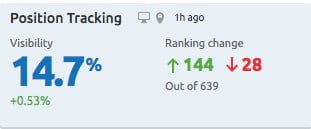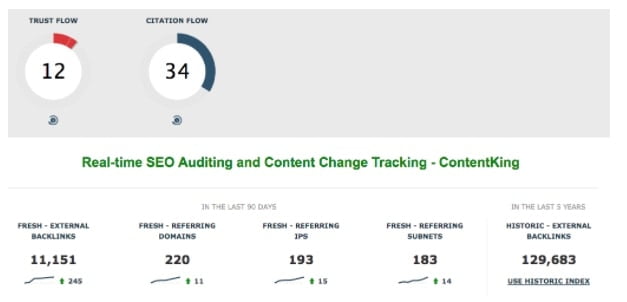Measuring the results of your SEO efforts is vital. But what KPIs should you be measuring? It’s easy to get distracted with details that don’t matter in the grand scheme of things.
In this article we’ll go over what KPIs matter when measuring SEO success. Put this knowledge to use to be more successful at SEO, build better reports, get approval for new budgets, up your monthly retainer, or get that promotion!
SEO brings you money by bringing relevant traffic to the site it helps promote. That traffic comes from rankings, and those rankings stem from backlinks and the content and shape of the website from a technical standpoint. For these properties we keep track of operational SEO KPIs around search visibility, backlinks, and crawl efficiency. To make this article easy to follow, we’re using that reasoning as the structure for the article.
Segmentation
Before we continue, it’s important to note that you need to segment KPIs.
Break down the KPIs discussed in this article using the following dimensions, as results can differ hugely between these dimensions, and breaking all it down gives you additional insights:
- Website sections or landing pages
- Devices (desktop, tablet or mobile)
- Location
- Search engine
A Note On Branded Traffic
Unless you’re running brand campaigns, leave out the branded traffic when reporting SEO success. In almost every case, a website ranks for its brand name automatically, so it’s not useful to include the branded traffic in the KPIs.
1. Revenue + ROI And Conversions
The number one metric to report on is revenue and ROI:
- How much money was made
- What investment was made
- What’s the ROI?
Example: if you made $50,000 in revenue on a $10,000 investment your ROI is:
(50,000 – 10,000) / $10,000 = 400%
When you’re spending money—and remember time is money too—you need to know what it gets you. Without that information, you’re in the dark, and you will definitely be spending time and money on the wrong things.
People with a business background often don’t care about rankings—they want to know how much money was made. Rightfully so! Thus this is the number one KPI to report on.
Getting your hands onto revenue data can prove difficult. It’s easy for an eCommerce site, but if you’re generating leads that need to be converted by a sales team, then it’s harder. You may be able to feed back revenue data into your web analytics suite, but if that’s not the case, it’s up to you to compile this data later on after the sale is made… provided your client is OK with revealing that data.
If there’s no way to get revenue data, you’re limited to reporting on conversions. Reporting only on conversions has the downside that it may be hard to get approval for budgets etc., because: what really is the ROI on the investment? You can try to overcome this by attributing an average value to conversions or taking into account the quality of the leads, but ideally you base it on real data.
2. Traffic: Sessions And Their Behaviour
SEO is all about driving relevant traffic to a website. When it comes to this traffic, you need to report on the number of sessions and on their characteristics.
Study the visitors you’ve reached. Each one is a (potential) lead. Keep a watchful eye on them and on the soft goals they’ve completed on your website. By “soft goals,” we mean goals such as trial accounts created and newsletter sign-ups.
These are the KPIs to report on:
- Sessions (so, including both new and returning visitors)
- Soft goals completed
- Assisted conversions
- Conversion rate for soft goals
- Time per session
- Pages per session
- Bounce rate
Use these KPIs to improve visitors’ engagement so that they ultimately complete more goals. On informational websites, that may occur when the time per session and pages per session go up and the bounce rate goes down. If you know this, then you need to make sure users stay on the website. Do this for instance by showing related pages in the content your visitors are reading, or by implementing eternal scrolling.
3. Rankings In Search Engines
For a long time, rankings in search engines were the most important KPI to report on for SEO. But rankings in search engines alone don’t necessarily mean anything, because you could have #1 rankings for search queries that are driving a lot of traffic that doesn’t convert.
That’s why it’s so important to look at traffic, behavior, and revenue. Having said that, rankings do play their part in measuring SEO success, because they help you understand why traffic is rising or falling.
Often the same page or pages within the same website section rank for related search queries, and therefore: group the search queries together and report on a group of search queries rather than on individual search queries. Here’s an example of keywords that may be ranking for the a product category page with Nike shoes:
- nike shoes
- nike sneakers
- nike shoes 2018
- nike sneakers 2018
Reporting on these metrics gives meaning to the groups of search queries:
- Search queries at position #1
- Search queries in the top 5
- Search queries in the top 10
- Search queries outside of the top 50
- The average position of search queries
It’s important to know whether search engine result pages contain features like those e.g. for images, videos, rich snippets, and Google Maps listings, as this influences the feasibility of your achieving high rankings and/or noteworthy traffic through these search queries. Instead, you may want to focus on search queries without these features.
4. Operational SEO KPI
When it comes to operational SEO KPIs measuring SEO success, here’s what you need to keep track of:
- Visibility in organic search results
- On-site optimisation
- Backlinks
- Crawl efficiency
4.1 Visibility in organic search results
Your visibility in organic search results is the market share you have within SEO. Each search query has a monthly search volume, and if you know the position of your website for that search query, you can calculate the estimated visitors you can expect.
There are numerous tools that calculate this automatically, among which are: SEMrush and Ahrefs. Don’t compare the visibility scores from one tool to another, because that’s comparing apples and oranges.
Don’t have access to a tool like this? Then you could do it manually as well, using for instance AWR’s click-through-data.
Screenshot from Ahrefs Rank Tracking overview page
Screenshot from SEMrush’s Project overview page
4.2 Website health
Your website’s health is an important KPI. Website health comprises search engine accessibility (the technical side of things) and on-page optimisation (all content search engine processes). Applications such as ContentKing monitor the health of websites and alert you in cases of trouble. They mimic search engine behavior and evaluate the health of your website. Among other things, these issues need to be taken into account when evaluating website health:
- Meta information (Title and Meta description)
- Headings
- Broken links
- Duplicate content
- Canonicalization
- XML sitemap integrity
- Robots.txt
Screenshot of ContentKing
4.3 Crawl efficiency
It’s important that search engines crawl your website efficiently—that search engines spend most of their attention for your website (a concept called crawl budget) on crawling pages that you want to appear in the search results, rather than non-indexable pages, redirects, 404s, and so on.
The metrics to look out for are:
- The number of pages you want to get indexed and the amount of pages actually indexed
- Number of pages crawled
- Avg. page load time (the lower the better, ideally below one second)
These metrics are shown in Google Search Console and Bing Webmaster Tools.
4.4 Backlinks
A backlink is a link from one page on a website to another. Each links passes on value, contributing to the value of the page that’s linked. The sheer amount of links isn’t that interesting, because having 1,000,000 links from one website to another adds little more value than for instance 10.
Two things are interesting—and they correlate with high rankings in search results:
- The number of referring domains.
- A domain’s authority. In each tool this is called differently; for instance within Majestic the authority is split up into Trust Flow and Citation Flow, while within Ahrefs it’s one metric: Domain Rating.
Screenshot from Ahrefs
Screenshot from Majestic
Conclusion
Tracking the success of your SEO efforts is important, but be sure to focus on the right KPIs. To save yourself a lot of time, and always have the KPIs available, it makes a lot of sense to set them up in an online dashboard like the one that Swydo offers. By integrating with Google Analytics, Search Console and Pagespeed, you can create powerful and comprehensive SEO reports. Learn more!
Bio:





